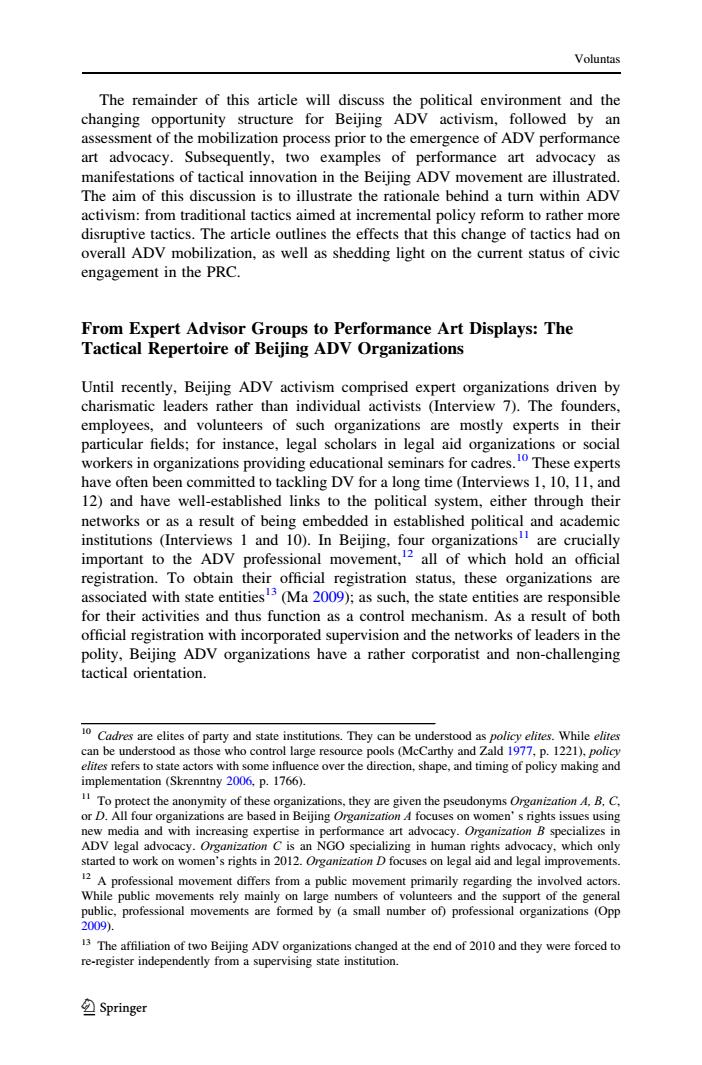正在加载图片...

Voluntas The remainder of this article will discuss the political environment and the changing opportunity structure for Beijing ADV activism,followed by an assessment of the mobilization process prior to the emergence of ADV performance art advocacy.Subsequently,two examples of performance art advocacy as manifestations of tactical innovation in the Beijing ADV movement are illustrated. The aim of this discussion is to illustrate the rationale behind a turn within ADV activism:from traditional tactics aimed at incremental policy reform to rather more disruptive tactics.The article outlines the effects that this change of tactics had on overall ADV mobilization,as well as shedding light on the current status of civic engagement in the PRC. From Expert Advisor Groups to Performance Art Displays:The Tactical Repertoire of Beijing ADV Organizations Until recently,Beijing ADV activism comprised expert organizations driven by charismatic leaders rather than individual activists (Interview 7).The founders, employees,and volunteers of such organizations are mostly experts in their particular fields;for instance,legal scholars in legal aid organizations or social workers in organizations providing educational seminars for cadres.These experts have often been committed to tackling DV for a long time (Interviews 1,10,11,and 12)and have well-established links to the political system,either through their networks or as a result of being embedded in established political and academic institutions (Interviews 1 and 10).In Beijing,four organizations are crucially important to the ADV professional movement,12 all of which hold an official registration.To obtain their official registration status,these organizations are associated with state entities3(Ma 2009);as such,the state entities are responsible for their activities and thus function as a control mechanism.As a result of both official registration with incorporated supervision and the networks of leaders in the polity,Beijing ADV organizations have a rather corporatist and non-challenging tactical orientation. Cadres are elites of party and state institutions.They can be understood as policy elires.While elires can be understood as those who control large resource pools (McCarthy and Zald 1977,p.1221),policy elites refers to state actors with some influence over the direction,shape,and timing of policy making and implementation(Skrenntny 2006,p.1766). To protect the anonymity of these organizations,they are given the pseudonyms Orgnizion B.C. or D.All four organizations are based in Beijing Organization A focuses on women's rights issues using new media and with increasing expertise in performance art advocacy.Organization B specializes in ADV legal advocacy.Organization C is an NGO specializing in human rights advocacy,which only started to work on women's rights in 2012.Organization D focuses on legal aid and legal improvements. A professional movement differs from a public movement primarily regarding the involved actors. While public movements rely mainly on large numbers of volunteers and the support of the general public,professional movements are formed by (a small number of)professional organizations(Opp 2009). 13 The affiliation of two Beijing ADV organizations changed at the end of 2010 and they were forced to re-register independently from a supervising state institution. 2SpringerThe remainder of this article will discuss the political environment and the changing opportunity structure for Beijing ADV activism, followed by an assessment of the mobilization process prior to the emergence of ADV performance art advocacy. Subsequently, two examples of performance art advocacy as manifestations of tactical innovation in the Beijing ADV movement are illustrated. The aim of this discussion is to illustrate the rationale behind a turn within ADV activism: from traditional tactics aimed at incremental policy reform to rather more disruptive tactics. The article outlines the effects that this change of tactics had on overall ADV mobilization, as well as shedding light on the current status of civic engagement in the PRC. From Expert Advisor Groups to Performance Art Displays: The Tactical Repertoire of Beijing ADV Organizations Until recently, Beijing ADV activism comprised expert organizations driven by charismatic leaders rather than individual activists (Interview 7). The founders, employees, and volunteers of such organizations are mostly experts in their particular fields; for instance, legal scholars in legal aid organizations or social workers in organizations providing educational seminars for cadres.10 These experts have often been committed to tackling DV for a long time (Interviews 1, 10, 11, and 12) and have well-established links to the political system, either through their networks or as a result of being embedded in established political and academic institutions (Interviews 1 and 10). In Beijing, four organizations11 are crucially important to the ADV professional movement,12 all of which hold an official registration. To obtain their official registration status, these organizations are associated with state entities13 (Ma 2009); as such, the state entities are responsible for their activities and thus function as a control mechanism. As a result of both official registration with incorporated supervision and the networks of leaders in the polity, Beijing ADV organizations have a rather corporatist and non-challenging tactical orientation. 10 Cadres are elites of party and state institutions. They can be understood as policy elites. While elites can be understood as those who control large resource pools (McCarthy and Zald 1977, p. 1221), policy elites refers to state actors with some influence over the direction, shape, and timing of policy making and implementation (Skrenntny 2006, p. 1766). 11 To protect the anonymity of these organizations, they are given the pseudonyms Organization A, B, C, or D. All four organizations are based in Beijing Organization A focuses on women’ s rights issues using new media and with increasing expertise in performance art advocacy. Organization B specializes in ADV legal advocacy. Organization C is an NGO specializing in human rights advocacy, which only started to work on women’s rights in 2012. Organization D focuses on legal aid and legal improvements. 12 A professional movement differs from a public movement primarily regarding the involved actors. While public movements rely mainly on large numbers of volunteers and the support of the general public, professional movements are formed by (a small number of) professional organizations (Opp 2009). 13 The affiliation of two Beijing ADV organizations changed at the end of 2010 and they were forced to re-register independently from a supervising state institution. Voluntas 123